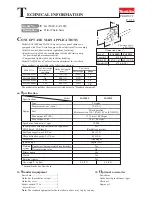
7
AdJuSTABle SHoe - (fIGuRe 8)
WARNING:
cuT HAzARd. Blade breakage
may occur if the blade does not extend past the
shoe and the workpiece during the cut. Increased
risk of personal injury, as well as damage to the
shoe and workpiece may result.
WARNING:
cuT HAzARd. Turn off and
disconnect tool from power source before making
any adjustments or removing or installing
attachments or accessories.
• The shoe will adjust to limit the depth of cut. Push the
button (shown in figure 8) on the hand grip and slide the
shoe out to the desired depth and release the button.
cAuTIoN:
cuT HAzARd. To prevent loss of control,
never use tool without shoe.
cAuTIoN:
RISk of PeRSoNAl INJuRy ANd
PRoPeRTy dAMAGe. Ensure the shoe is locked into
position before using tool.
fluSH cuTTING (fIGuRe 9)
• The compact design of the recipro cating saw motor housing
and pivoting shoe permit close cutting to floors, corners and
other difficult areas.
• To maximize flush cutting capabilities, insert the blade shaft
into the blade clamp with the teeth of the blade facing up.
• Turn the saw upside down so you are as close to
the work surface as possible.
MeTAl cuTTING (fIGuRe 10)
• Use a finer blade for ferrous metals and a coarse
blade for non-ferrous materials.
• In thin gauge sheet metals it is best to clamp
wood to the underside of the sheet. This will
ensure a clean cut without excess vibration or
tearing of metal.
• Avoid forcing cutting blade as this reduces blade
life and causes costly blade breakage.
NoTe: Spread a thin film of oil or other coolant
along the line ahead of the saw cut for easier
operation and longer blade life.
PockeT cuTTING - Wood oNly (fIGuRe 11)
• Measure the surface area to be cut and mark
clearly with a pencil, chalk or scriber.
• Insert blade in blade clamp and tighten blade
clamp securely.
• Tip the saw backward until the back edge of the
shoe is resting on the work surface and the fully
extended moving blade will clear the surface.
• Grip unit with both hands, switch motor on
permitting blade to obtain maximum speed.
• Begin a slow, deliberate upward swing with the
main handle of the saw.
• The blade will begin to feed into material. Always
be sure blade is completely through material before continuing with pocket cut.
NoTe: In areas where blade visibility is limited, use the edge of the shoe as a guide.
PRoJecT TIPS
• Cut only with sharp blades; they cut cleaner, faster and put less strain on the motor
while cutting.
• When cutting, always ensure that the shoe is held firmly against the workpiece and
the workpiece is secured from moving/deflecting. This will improve operator control
and minimize vibration.
• For longer blade life, use bi-metal blades. These utilize a carbon steel back welded
to high speed steel teeth making the blade more flexible and less prone to breaking.
9
8
11
10








































